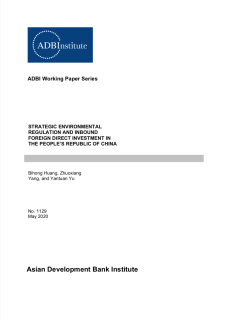
Using a new dataset on foreign direct investment (FDI) and a comprehensive measurement of environmental policy stringency and enforcement, this paper studies the spatial distribution of inbound FDI in manufacturing sectors by accounting for strategically determined environmental policies across Chinese cities over the period 2003–2014. In particular, it investigates how the stringency of environmental regulation affects the FDI inflow of a city and its neighbors. It provides strong evidence that the pollution haven hypothesis applies to the People’s Republic of China based on both spatial lag of X and two-stage least-squares estimates. In particular, the laxity of a city’s own environmental regulation is positively associated with its inbound FDI. It further investigates the investment deflection effect and find that the laxity of neighboring environmental regulation is negatively related to the FDI inflows to a city. Even though the central Chinese government issues strict regulation policies, it is the local governments’ discretion to adjust and enforce compliance.
